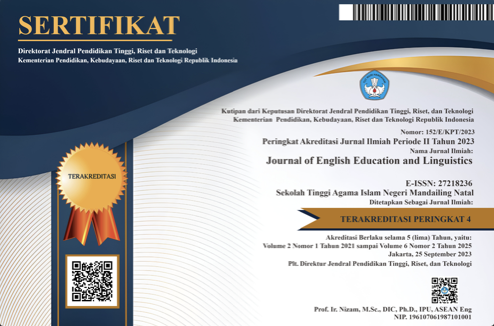GAPS BETWEEN EXPERT’S AND STUDENT’S EXPOSITION TEXTS BASED ON SYSTEMIC FUNCTIONAL LINGUISTICS (SFL): IMPLICATION FOR TEACHERS
DOI:
https://doi.org/10.56874/jeel.v2i1.420Abstract
The lack of students’ ability to compose expository text is still found in many mainstream classrooms. The inability may be caused by many factors such as the complexity of the text itself, the texts in the textbook which are often not representative enough to be the model texts, and teachers’ lack of awareness of teaching genre. This study intends to investigate the gaps between the model (expert) and students’ texts at genre level and register level based on SFL perspectives. To serve the aims, this study employed case study design in attempt to get clear description from the case investigated. The data gathered from the analysis focusing on genre level and register level were presented in narrative form and interpreted descriptively. The finding showed that at genre level the student’s text did not include the restatement of thesis which is different from the expert’s text. Meanwhile, at register level, the student’s text appears to have lack of cohesive devices and other mode choices (e.g. lack of marked theme, connectives) which lead into the lack of texture of the text. Careful design of activities in each curriculum cycle and explicit teaching of both schematic structures and registers of expository are the implications suggested by this study.
References
Butt, D., Fahey, R., Feez, S., Spinks, S., & Yallop, C. (2006). Using functional Grammar: An explorer’s guide. Sydney: NSW: National Center for English Language Teaching and Research.
Christie, F., & Derewianka, B. (2008). School discourse: Learning to write across the years of schooling. London: Continuum.
De Oliveira, L., & Lan, S.-W. (2014). Writing science in an upper elementary classroom: A genre-based approach to teaching English language learners. Journal of Second Language Writing, 23–39.
Derewianka, B. (1990). Exploring how texts work. Sydney: Primary English Teaching Association.
Eggins, S. (1994). An introduction to systemic functional linguistics. London: Ltd. Eggins, S. (2004). An Introduction to Systemic Functional Linguistics . New York:
Continuum.
Emilia, E. (2005). A Critical Genre- Based Approach to Teaching Academic Writing in
a Tertiary EFL Context in Indonesia. Sydney: The University of Melbourne. Emilia, E. (2014). Introducing Functional Grammar. Bandung: Pustaka Jaya.
Feng, H., & Liu, Y. (2010). Analysis of Interpersonal Meaning in Public Speeches- A
Case Study of Obama’s Speech. Journal of Language Teaching and Research,
Vol. 1, No. 6, pp. 825-829.
Fraenkel, J. R., Wallen, N. E., & Hyun, H. H. (2012). How to Design And Evaluate
Research in Education (Eight Edition). New York: Mc Graw Hill Companies,
Inc.
Gray, D. E. (2004). Doing Research in tthe Real World. London, Thousand Oaks, New
Delhi: SAGE Publications.
Halliday, M. (1985). An Introduction to Functional Grammar. London: Edward Arnold.
Knapp, P., & Watkins, M. (2005). Genre, text, grammar: Technologies for teaching and assessing writing. Sydney: UNSW Press.
Murphy , S. (2013). Assessing Text Difficulty for Students. Ontario: Literacy and Numeracy Secretariat.
Panjaitan, M. (2013). Analysis of Content Standards for English in Junior Secondary School and Senior Secondary School. Jurnal Pendidikan dan Kebudayaan, 19 (1) 120-155.
Schleppegrell, M. (2004). The Language of schooling: A functional linguistics perspective. Mahwah, NJ : Lawrence Erlbaum Associates.
Schleppegrell, M. J., & Go, A. L. (2007). Analyzing the Writing of English Learners: A Functional Approach. Language Arts, 84(6), 529-539.
State Literacy and Numeracy Plan. (1999). Focus on Literacy. NSW Department of Education and Training Curriculum Support Directorate.
Thompson, G. (2004). Introduction to functional grammar (2nd edition). London: Arnold Publishers.
Downloads
Published
Issue
Section
License
All articles published in the Journal of English Education and Linguistics are licensed under a Creative Commons Attribution-ShareAlike 4.0 International (CC BY-SA) license. This means anyone is free to copy, transform, or redistribute articles for any lawful purpose in any medium, provided they give appropriate attribution to the original author(s) and Journal of English Education and Linguistics, link to the license, indicate if changes were made, and redistribute any derivative work under the same license.
Copyright on articles is retained by the respective author(s) without restrictions. A non-exclusive license is granted to the Journal of English Education and Linguistics to publish the article and identify itself as its original publisher, along with the commercial right to include the article in a hardcopy issue for sale to libraries and individuals.
Although the conditions of the Creative Commons Attribution-ShareAlike 4.0 International (CC BY-SA) license do not apply to authors (as the copyright holder of your article, you have no restrictions on your rights), by submitting to the Journal of English Education and Linguistics, authors recognize the rights of readers and must grant any third party the right to use their articles to the extent provided by the license.

This work is licensed under a Creative Commons Attribution-ShareAlike 4.0 International License.








